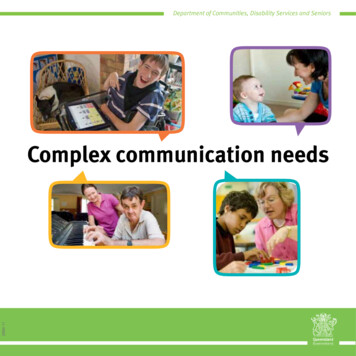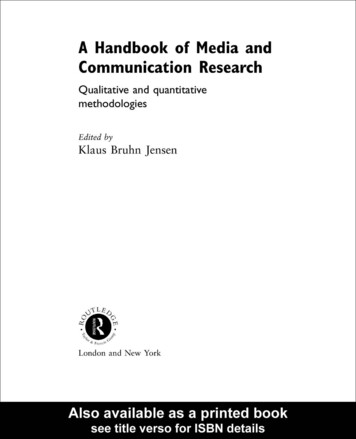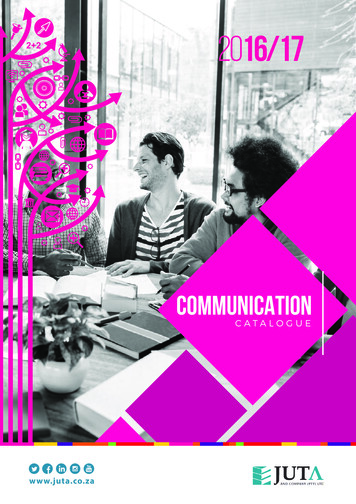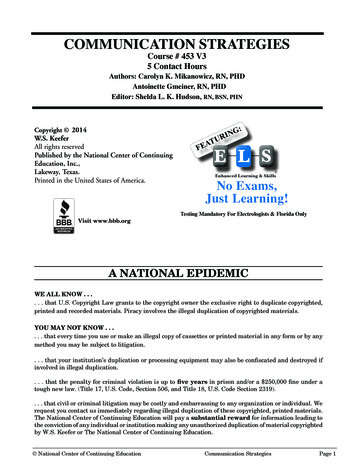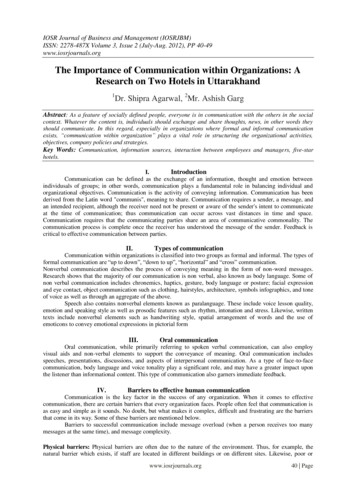
Transcription
IOSR Journal of Business and Management (IOSRJBM)ISSN: 2278-487X Volume 3, Issue 2 (July-Aug. 2012), PP 40-49www.iosrjournals.orgThe Importance of Communication within Organizations: AResearch on Two Hotels in Uttarakhand1Dr. Shipra Agarwal, 2Mr. Ashish GargAbstract: As a feature of socially defined people, everyone is in communication with the others in the socialcontext. Whatever the content is, individuals should exchange and share thoughts, news, in other words theyshould communicate. In this regard, especially in organizations where formal and informal communicationexists, “communication within organization” plays a vital role in structuring the organizational activities,objectives, company policies and strategies.Key Words: Communication, information sources, interaction between employees and managers, five-starhotels.I.IntroductionCommunication can be defined as the exchange of an information, thought and emotion betweenindividusals of groups; in other words, communication plays a fundamental role in balancing individual andorganizational objectives. Communication is the activity of conveying information. Communication has beenderived from the Latin word "communis", meaning to share. Communication requires a sender, a message, andan intended recipient, although the receiver need not be present or aware of the sender's intent to communicateat the time of communication; thus communication can occur across vast distances in time and space.Communication requires that the communicating parties share an area of communicative commonality. Thecommunication process is complete once the receiver has understood the message of the sender. Feedback iscritical to effective communication between parties.II.Types of communicationCommunication within organizations is classified into two groups as formal and informal. The types offormal communication are “up to down”, “down to up”, “horizontal” and “cross” communication.Nonverbal communication describes the process of conveying meaning in the form of non-word messages.Research shows that the majority of our communication is non verbal, also known as body language. Some ofnon verbal communication includes chronemics, haptics, gesture, body language or posture; facial expressionand eye contact, object communication such as clothing, hairstyles, architecture, symbols infographics, and toneof voice as well as through an aggregate of the above.Speech also contains nonverbal elements known as paralanguage. These include voice lesson quality,emotion and speaking style as well as prosodic features such as rhythm, intonation and stress. Likewise, writtentexts include nonverbal elements such as handwriting style, spatial arrangement of words and the use ofemoticons to convey emotional expressions in pictorial formIII.Oral communicationOral communication, while primarily referring to spoken verbal communication, can also employvisual aids and non-verbal elements to support the conveyance of meaning. Oral communication includesspeeches, presentations, discussions, and aspects of interpersonal communication. As a type of face-to-facecommunication, body language and voice tonality play a significant role, and may have a greater impact uponthe listener than informational content. This type of communication also garners immediate feedback.IV.Barriers to effective human communicationCommunication is the key factor in the success of any organization. When it comes to effectivecommunication, there are certain barriers that every organization faces. People often feel that communication isas easy and simple as it sounds. No doubt, but what makes it complex, difficult and frustrating are the barriersthat come in its way. Some of these barriers are mentioned below.Barriers to successful communication include message overload (when a person receives too manymessages at the same time), and message complexity.Physical barriers: Physical barriers are often due to the nature of the environment. Thus, for example, thenatural barrier which exists, if staff are located in different buildings or on different sites. Likewise, poor orwww.iosrjournals.org40 Page
The Importance Of Communication Within Organizations: A Research On Two Hotels In Uttarakhanoutdated equipment, particularly the failure of management to introduce new technology, may also causeproblems. Staff shortages are another factor which frequently causes communication difficulties for anorganization. Whilst distractions like background noise, poor lighting or an environment which is too hot or coldcan all affect people's morale and concentration, which in turn interfere with effective communication.System design: System design faults refer to problems with the structures or systems in place in anorganization. Examples might include an organizational structure which is unclear and therefore makes itconfusing to know who to communicate with. Other examples could be inefficient or inappropriate informationsystems, a lack of supervision or training, and a lack of clarity in roles and responsibilities which can lead tostaff being uncertain about what is expected of them.Attitudinal barriers: Attitudinal barriers come about as a result of problems with staff in an organisation.These may be brought about, for example, by such factors as poor management, lack of consultation withemployees, personality conflicts which can result in people delaying or refusing to communicate, the personalattitudes of individual employees which may be due to lack of motivation or dissatisfaction at work, broughtabout by insufficient training to enable them to carry out particular tasks, or just resistance to change due toentrenched attitudes and ideas.Ambiguity of Words/Phrases: Words sounding the same but having different meaning can convey a differentmeaning altogether. Hence the communicator must ensure that the receiver receives the same meaning. It wouldbe better if such words can be avoided by using alternatives.Individual linguistic ability is also important. The use of difficult or inappropriate words in communicationcan prevent people from understanding the message. Poorly explained or misunderstood messages can alsoresult in confusion. We can all think of situations where we have listened to something explained which we justcould not grasp. Interestingly, however, research in communication has shown that confusion can lendlegitimacy to research when persuasion fails.Physiological barriers: may result from individuals' personal discomfort, caused—for example—by ill health,poor eyesight or hearing difficulties.Presentation of information: is also important to aid understanding. Simply put, the communicator mustconsider the audience before making the presentation itself and in cases where it is not possible the presentercan at least try to simplify his/her vocabulary so that majority can understand.Importance of Effective Communication: No matter how brilliant and invaluable your idea, it is worthlessunless you can share it with others. For this reason, effective communication is crucial at every level of anorganization. However, the ability to communicate effectively does not come easily to many people, and it is askill that requires practice.We begin practicing our communication skills even before we learn to walk. A newborn childcommunicates by crying, but it slowly learns to mimic its parents’ speech. Eventually, the child discovers thatcertain speech patterns elicit different responses; one of the joys of parenting is trying to decipher the meaningbehind certain “words.” Does “baaaaaw” mean that the baby wants his ball, his bottle, or his blanket? Slowly,through trial and error, the child learns to manipulate sounds to get what it wants, and as the child develops, thisactive oral practice leads to more nuanced and fluid conversations. In short, the child learns effectivecommunication. To effectively communicate a complex idea, however, requires skills beyond elementaryconversation. There are two golden rules to remember and follow.Organize thoughts before sharing: One idea often prompts a torrent of others. In order to share your ideas,you must first shape them coherently. Organization is important, because it creates a pattern for your listener,allowing him or her to grasp the larger picture intuitively. This allows the listener to focus on the details of yourmessage, without struggling to understand how you went from Point A to Point B. As a thought experiment,imagine that a colleague has asked you for directions to the airport. Write them down. Your directions willprobably look something like: Drive west half a mile on Aurora. Take a left on Madison. At the third light, turn right and follow Dexter for 2-3 miles. Get on the interstate, heading south.www.iosrjournals.org41 Page
The Importance Of Communication Within Organizations: A Research On Two Hotels In UttarakhanNow, with a pair of scissors, cut each line of instructions into a small strip of paper. Jumble the strips up andarrange them in a completely random order, then give them to your colleague. Even with mixed-up directions,s/he should have no trouble reaching the airport, right? After all, your directions are complete and accurate. Nota single step is missing. The problem, of course, is that your directions are also completely unorganized,rendering them useless. Your colleague will find it impossible to focus on your message itself, because he or shewill struggle to follow your message’s structure (or lack thereof).Communication: Collaborative, not Competitive: Thrusting your idea on others mars the beauty and integrityof conversation. Communication is in some ways like a dance; each partner plays off the other, basing his or hersteps on the other person’s, while simultaneously maintaining a certain amount of individuality. Communicationis a two-way process involving an exchange of ideas. If you try to make it one-way, you prevent this exchangeand will eventually frustrate the other person. You may also frustrate yourself, if you read the other person’slack of verbosity as disinterest in the conversation, rather than an inability to get a word in. The hallmark ofeffective communication is the coherent verbal projection of you ideas, so that your listener receives themessage that you intend to send. By observing these two rules, you will reduce miscommunication andmisunderstandings.V.Aim of the researchThe aim of this research is trying to explain the importance of communication in two 4 star hotels in DehradunRegion. In this respect, communication types, tools, sources, interaction between employees in different levelsof hotels are investigated.VI.Content and methodology of the researchThis paper aims to find out real situation of communication levels. Because of its touristic potential, Dehradunregion was selected as a sample. According to Regional Tourism Directory, two 4 star hotels have been includedin our research.The questionnaire consists of 30 questions, all of which are close-ended. In this paper only theimportant results were shown. Questionnaires were answered by 65 employees consisting of 36 employees fromdifferent departments of Hotel X which is a member of a famous hotels chain and 29 employees from differentdepartments of Hotel Y operating as a single organization. For statistical evaluation, SSPS has been used.Graphic 1Chart 1 shows a ranking of departments as stated by the hotels contacted: It can be inferred from the above chartthat Housekeeping (36%), food and beverage (22%), front office (11%), human resource (11%) Accounting &finance (15%), technical services (5%).Chart 2 shows a ranking of employee’s job experiences:www.iosrjournals.org42 Page
The Importance Of Communication Within Organizations: A Research On Two Hotels In Uttarakhan 33 % of the employees are working at the same department for more than 6 years, 22 % of them (for 4-6years), 32 % of employees (for 1-3 years), 5% of them are working at the same department(for 6 months1 year), 6 % of them (for less than 6 months)35 % of employees are working at the same hotel for more than 6 years, 23% are working (for 4-6 years),34% of them (for 1-3 years), 2% for (6months- 1 year), 5% of them (for less than 6 months).23 % of them (for more than 6 years), 19 % of them (for 4-6 years), 36 % of employees are working withthe same supervisors (for 1-3 years), 4 % of them (6 months- 1 year), 25 % of them (for less than 6months),Chart 3 shows a ranking of information sources within the hotel as stated by the hotels contacted: Memos(24%), supervisors (15%), coworkers (14%), employee meetings with top management and documents reportedto departments (11%), bulletin boards (10%), E-mail and training possibilities (4%), workplace/staff meetingswith boss (3%).This ranking shows a normal communications levels in the sampled hotels. In communication, writtencommunication plays an important role as well as oral communication. At this context the rate of using bulletinboards, workplace staff meetings, E-mail connections can be increased.Chart4 shows a ranking of information sources within the hotel in order of employee’s preferences:Memos and employee meetings with top management (16%), supervisors (13%), training (12%), Newspaper(7%), Documents reported to departments (8%), bulletin boards (8%), and coworkers (6%).These results again show the importance of written and oral communication within sampled hotels. Accordingto employee’s preferences information sources with the top three are memos and employee meetings,supervisors and training.Chart 5 ranks communication within own department with the top three: face to face (51%),telephone/mobile telephone (28%) and group meeting (9%). It can be inferred from it that face to facecommunication is the most trusted way of communication within own department.www.iosrjournals.org43 Page
The Importance Of Communication Within Organizations: A Research On Two Hotels In UttarakhanChart 6 ranks communication with other departments with the top three: telephone/mobile telephone (43%), faceto face (40%), and memos/note/fax (10%).It can be inferred from the above chart that when communicated with other department the mostpreferred way of communication is telephone/mobile. Both in graphic 3 and 4 with little changes in the order,the most important communication tools are nearly the same. With its less importance, E-mail connections arealso preferred because of its speed and economic aspects.Chart 7 shows a ranking of communication preferences according to departments: Food & Beverage; telephone/mobile phone (44%), face to face (40 %), group meeting (8%),memos/note/fax and E-mail (4%). Housekeeping; face to face (41%), telephone/mobile phone (33 %), group meeting (15 %),memos/note/fax (9%), E-mail (2%). Accounting & Finance: telephone/mobile phone (38 %), face to face, memos/note/fax, group meeting, Email (%15). Human Resources; face to face and telephone/mobile phone (36%), group meeting (18 %),memos/note/fax (9%). Front Office; telephone/mobile phone (35 %), face to face (25%), memos/note/fax and group meeting(15%), E-mail (%10).Technical Services; face to face and telephone/mobile phone (43 %), group meeting (%14).“How often do you communicate with your manager?”The frequency of communication with the managers according to ranking are: daily (70%), weekly (10%),monthly (7%), never (4%), twice in a month (5%) and about every other months (4%).When these resultsexamined, it will be seen that most of the employees are communicating with the managers on a daily basis.This situation will support co-operation, problem solving and communication among employees.www.iosrjournals.org44 Page
The Importance Of Communication Within Organizations: A Research On Two Hotels In Uttarakhan“Does your manager encourage you and offer better job ideas in one-on-one interactions?”Chart 9 shows a ranking of encouraging employees to do job better: 25% of managers (all the time), 23% ofmanagers (25% of their times), 15% of managers (75% of their times), 15% of managers (50% of their times),For encouraging employees to do job better much more importance must be given.“How often does your manager meet you to review your performance objectives?”Chart10 shows a ranking of reviewing employee’s performance objectives by managers: monthly (38%), never(21%), three times a year and more (20%), once a year (21%). From these results it can be said that sampledhotels have to be more interested in reviewing employee performance objectives. Because this subject is relatedwith career planning and general performance of the hotels. Informing standards for performance criteria everyhotel must evaluate its own structure and activity.“How often does your manager seek your advice before decision making that can directly affect yourjob?”Chart 11 shows a ranking of asking employee ideas by managers making decisions: 35 % of managers (all thetime), 17 % of managers (50% of their times), 14% of managers (75% of their times), 12% of managers (25% oftheir times).Generally asking employee ideas before making decisions will increase motivation and give belonging feelingto employees.“Does your manager gives you feedback about your performance in job hence you can improve futureperformance?”0% of the time25% of the time75% of the time100% of the time50% of the time13%18%50%9%10%www.iosrjournals.org45 Page
The Importance Of Communication Within Organizations: A Research On Two Hotels In UttarakhanChart 12 shows a ranking of giving feedback by managers: 50% of managers (all the time), 18 % of managers(25 % of their times), 10 % of managers (50 % of their times), 5 % of managers (75 % of their times).Having information about performance results is important for both managers and employees. Performanceresults can be helpful for hotels determining deviations between targets and outputs.“Characterize your interactions with your own department with respect to the given adjectives.”Competitive- hart 13 shows a ranking of employee interactions with own department: cooperative (84%), competitive(10%), neutral (6%).Most of the employees evaluate the interactions with their own department as cooperative. This situation willmake communication mativeNeutral10%18%72%14 Chart 14 shows a ranking of employee interactions with own department: informative (72%), uninformative(18%), neutral (10%).Blaming-Problem SolvingProblem solvingBlamingNeutral15%5%80%Chart 15 shows a ranking of employee interactions with own department: problem-solving (80%), neutral(15%), blaming (5%).Both in graphic 14 and 15 it seems there is no problem in employee interactions related with being informativeand problem-solving.“Characterize your interactions with the employees of other departments with respect to the givenadjectives.”www.iosrjournals.org46 Page
The Importance Of Communication Within Organizations: A Research On Two Hotels In itiveNeutral10%15%75%Chart 16 shows a ranking of employee interactions with other departments: cooperative (75%), neutral (10%),competitive tiveNeutral10%16%74%Chart 17 shows a ranking of employee interactions with own department: informative (74%), neutral (10%),uninformative (16%).Blaming-Problem SolvingProblem Solving15%BlamingNeutral5%80%Chart 18 shows a ranking of employee interactions with other departments: problem-solving (80%), neutral(5%), blaming (15%).Both in graphic 16, 17 and 18, it seems there is no problem according to interactions with other departments inbeing cooperative, problem-solving and informative.VII.Analysis Of Hotel ComparisonsThe analysis mentioned before are the combined results of the two four-star hotels. The results showthat two sampled hotels have a general tendency to communicate within the same pattern and employ the sametypes and tools of communication, although some minor variations are observed.Below mentioned analysis are based on the comparison of the two sampled hotels according to theemployee performance objectives, team working, open door policy and usage of the open door policy subjects.www.iosrjournals.org47 Page
The Importance Of Communication Within Organizations: A Research On Two Hotels In Uttarakhan“How often does your manager meet you in order to review your performance objectives?”50403020100XNeverOnce aYearThreeTimes In aYear ormoreOtherY“How often does your manager ask for your ideas before making decisions that affect your job?”“Does your manager give you enough feedback about the way you perform so that you can improve yourjob performance?”“Are you aware of the Open Door Policy?”In terms of open door policy, 65 % of the Hotel X employees states that they are familiar with the open doorpolicy concept as oppose to 35 % of them do not know what it means. On the other hand, 47 % of the Hotel Yemployee’s states that they are familiar with the open door policy concept as oppose to 53 % of them do notknow what it means. This difference can be again attributed to the characteristics of the Hotel X being a memberof a big chain.“Have you ever used Open Door Policy to take your concern directly to higher management?”Although as discussed in chart 25, 65 % of the Hotel X employees states that they are familiar with the openwww.iosrjournals.org48 Page
The Importance Of Communication Within Organizations: A Research On Two Hotels In Uttarakhandoor policy concept, 27 % of them “100 % of the time” makes use of this as oppose to 37 % of the Hotel Yemployees using “100 % of the time”. In addition to this argument, 34 % of the Hotel X employees states thatthey “never” use this approach as oppose to 20 % of the Hotel Y employees. This results show that being amember of a chain and knowing the approaches does not guarantee the usage and performance.Results and Comments1.2.3.4.5.6.7.8.9.Memos, Supervisors and Co-workers are the three mostly used information sources as stated by the sample hotels. Employeepreferences show a similar preference to Memos and Employee Meetings With top management, Face to Face with supervisors andtraining possibilities. Equal importance should be given to oral and written communication. In order to increase the effectiveness,much more attention must be given to bulletin boards, hotel newspapers and E-mail connections.The ways of communication within/with other departments show very little change in the order; face to face and telephone/mobilephone possibilities. For communication with other department’s sampled hotels prefer memos/note/fax possibilities. Forcommunication within department sample hotels prefer group meetings.According to the research, in the sampled hotels telephone/mobile is the most preferred followed by face to face communicatio n byfood & Beverage, Housekeeping mostly prefer face to face; accounting & finance mostly prefer telephone/mobile phone; humanresources mostly prefer face to face and telephone/ mobile phone; Front Office mostly prefer telephone/mobile phone; TechnicalService mostly prefer face to face and telephone/mobile phone.It is found that most of the employees said that they get an opportunity to communicate with their managers daily. This situationenables cooperation, problem solving, mutual understanding, group dynamics and communication among employees.According to the result much more importance should be given to encourage their employees and offer them better job ideas. This willhelp them to be innovative and will increase their efficiency.Review of the performance objectives of employees by their employers should be given more importance. This will help in increasingmotivation, feeling of belongingness, employee loyalty as this play an important role.Most of the employees see their colleagues as informative, problem-solving, cooperative whether in their own department or in otherdepartments.In the sampled hotels most of the employees state that they have accurate and sufficient information from supervisor/managers ontime. Communication with management subject plays a critical role in communication.For sampled hotels it can be said that employees have a good cooperation in asking suggestions or providing help to each other.Evaluating data generally, will enable to state the real communication situation of sampled hotels. Sampled hotels have normal levelsof formal communication from “down to up” with communication between employees and managers, asking employee ideas beforemaking decisions, but in encouraging employees managers must be more interested. From “up to down” employees accept the curre ntcommunication situation. For increasing the effectiveness much more importance can be given to written communication like bulletinboards, hotel newspapers. Having sufficient, accurate information is also supporting the current “up to down” communication. From“horizontal” and “cross” communication, employees see their colleagues as informative, problem-solving, cooperative both in theirand in other departments.Consequently, it can be said that sampled hotels have a normal formal communication with sufficientinformation flows supporting “up to down”, “down to up”, “horizontal” and “cross” communications. As a whole they have thepossibility to complete their communication policy with their corporate policy.www.iosrjournals.org49 Page
effective communication is the coherent verbal projection of you ideas, so that your listener receives the message that you intend to send. By observing these two rules, you will reduce miscommunication and misunderstandings. V. Aim of the research The aim of this research is trying to explain the importance of communication in two 4 star .



